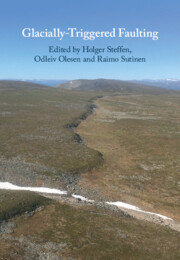Book contents
- Glacially-Triggered Faulting
- Glacially-Triggered Faulting
- Copyright page
- Contents
- Figures
- Tables
- Contributors
- Preface
- Part I Introduction
- Part II Methods and Techniques for Fault Identification and Dating
- Part III Glacially Triggered Faulting in the Fennoscandian Shield
- 10 Seismicity and Sources of Stress in Fennoscandia
- 11 Postglacial Faulting in Norway
- 12 Glacially Induced Faults in Sweden
- 13 Glacially Induced Faults in Finland
- 14 Lateglacial and Postglacial Faulting in the Russian Part of the Fennoscandian Shield
- Part IV Glacially Triggered Faulting at the Edge and in the Periphery of the Fennoscandian Shield
- Part V Glacially Triggered Faulting Outside Europe
- Part VI Modelling of Glacially Induced Faults and Stress
- Part VII Outlook
- Index
- References
12 - Glacially Induced Faults in Sweden
The Rise and Reassessment of the Single-Rupture Hypothesis
from Part III - Glacially Triggered Faulting in the Fennoscandian Shield
Published online by Cambridge University Press: 02 December 2021
- Glacially-Triggered Faulting
- Glacially-Triggered Faulting
- Copyright page
- Contents
- Figures
- Tables
- Contributors
- Preface
- Part I Introduction
- Part II Methods and Techniques for Fault Identification and Dating
- Part III Glacially Triggered Faulting in the Fennoscandian Shield
- 10 Seismicity and Sources of Stress in Fennoscandia
- 11 Postglacial Faulting in Norway
- 12 Glacially Induced Faults in Sweden
- 13 Glacially Induced Faults in Finland
- 14 Lateglacial and Postglacial Faulting in the Russian Part of the Fennoscandian Shield
- Part IV Glacially Triggered Faulting at the Edge and in the Periphery of the Fennoscandian Shield
- Part V Glacially Triggered Faulting Outside Europe
- Part VI Modelling of Glacially Induced Faults and Stress
- Part VII Outlook
- Index
- References
Summary
Despite early studies indicating fault rupture both before and after deglaciation, it has long been hypothesized that glacially induced faults in Fennoscandia ruptured only once. The now widespread availability of high-resolution digital elevation models allows for testing this hypothesis by examining cross-cutting relationships between the scarps and both glacial and postglacial landforms. Although not widespread, such cross-cutting relationships indicate that segments of the Merasjärvi, Lainio and Pärvie faults have ruptured at least twice. The timing of the Merasjärvi ruptures is unknown; the Lainio ruptures occurred both before and after deglaciation, and at least one of the Pärvie ruptures is postglacial.
Additionally, it can be demonstrated that parallel segments of the Pärvie and Lansjärv faults ruptured at different times despite being only a few kilometres from each other. Given these results, the single rupture hypothesis must be reassessed for the high-relief scarps in northern Sweden, but it may still hold true for some of the low-relief scarps.
Keywords
- Type
- Chapter
- Information
- Glacially-Triggered Faulting , pp. 218 - 230Publisher: Cambridge University PressPrint publication year: 2021
References
- 1
- Cited by



